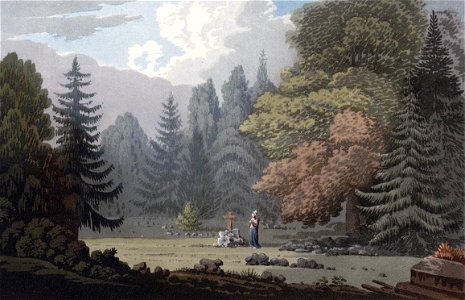No. Lxiv. Burial ground at larkoul. About the centre of the volcanic island, at larkoul, on a small plain, between the hills, is a little cemetery for the reception of the remains of ship-wrecked mariners, and of other strangers from distant parts, who unfortunately have been lost on the shores of these islands. It is closely embowered in a thick grove of firs and other trees, whose large branches, like cypresses, rest their lower leaves on the ground, forming a screen all around, through which it is difficult to penetrate, for the purpose of viewing the solemn and interesting area within. On entering it, the spectator beholds an arrangement of stones on the ground, representing rude circles, and oblong figures; many of them have a tree, flower, or shrub, within, or at the head of them; others have a small pile of stones, with a little wooden cross, and in some there is a triangular figure of the same material, which is very general in norwegian church yards. On each of the last-mentioned ornaments are imperfect letters, and parts of inscriptions, time having nearly obliterated the sad traces of these heart-rending records, which used to decorate the last homes of many brave and unfortunate human beings. On one were the words hans ter 60. On others were imperfectly deciphered the name and country of the deceased. As the interments in many cases do not admit delay, the corpse is immediately carried with decent solemnity in a boat, from the place where it was found, to the shore of this island, from whence it is born on a bier, and followed to the grave by the oldest man present, (if the priest be absent) and there silently interred. As churches in norway are generally at a considerable distance inland from those places, the cus tom invariably observed in regard to the rites of sepulture is as follows: on the first convenient opportunity after the interment, the pastor of the parish visits the grave, and reads over it the funeral service, during which he pours from a spoon, a little consecrated earth, which he brings with him from his church-yard. The unstudied demeanour of the persons, when paying their solemn visitations to their sleeping friends or relatives, is highly honourable to their feelings, and a most excellent example to all who are under affliction, or who sympathize in it. Even the untutored boor on these occasions, is often arrested on his way by a secret impulse of nature, and mutely and insensibly pays them in passing, the homage of uncovering his head. A young female, in whose heart the fine threads of love and friendship were interwoven, has been often seen, shedding the silent tear, or deco rating (like the maid of corinth) the humble tomb of her faithful departed lover. In this silent little retreat, the sublimest contemplations engross the mmd, and an involuntary tear drops from the eye in pity to misfortune. Very near the place is the remarkable stone, described in plate 63, and over the trees, is seen the crater, with the varde or mark on its summit. Date: 1800. Burial ground at Larkoul (JW Edy plate 64)
Loading...
